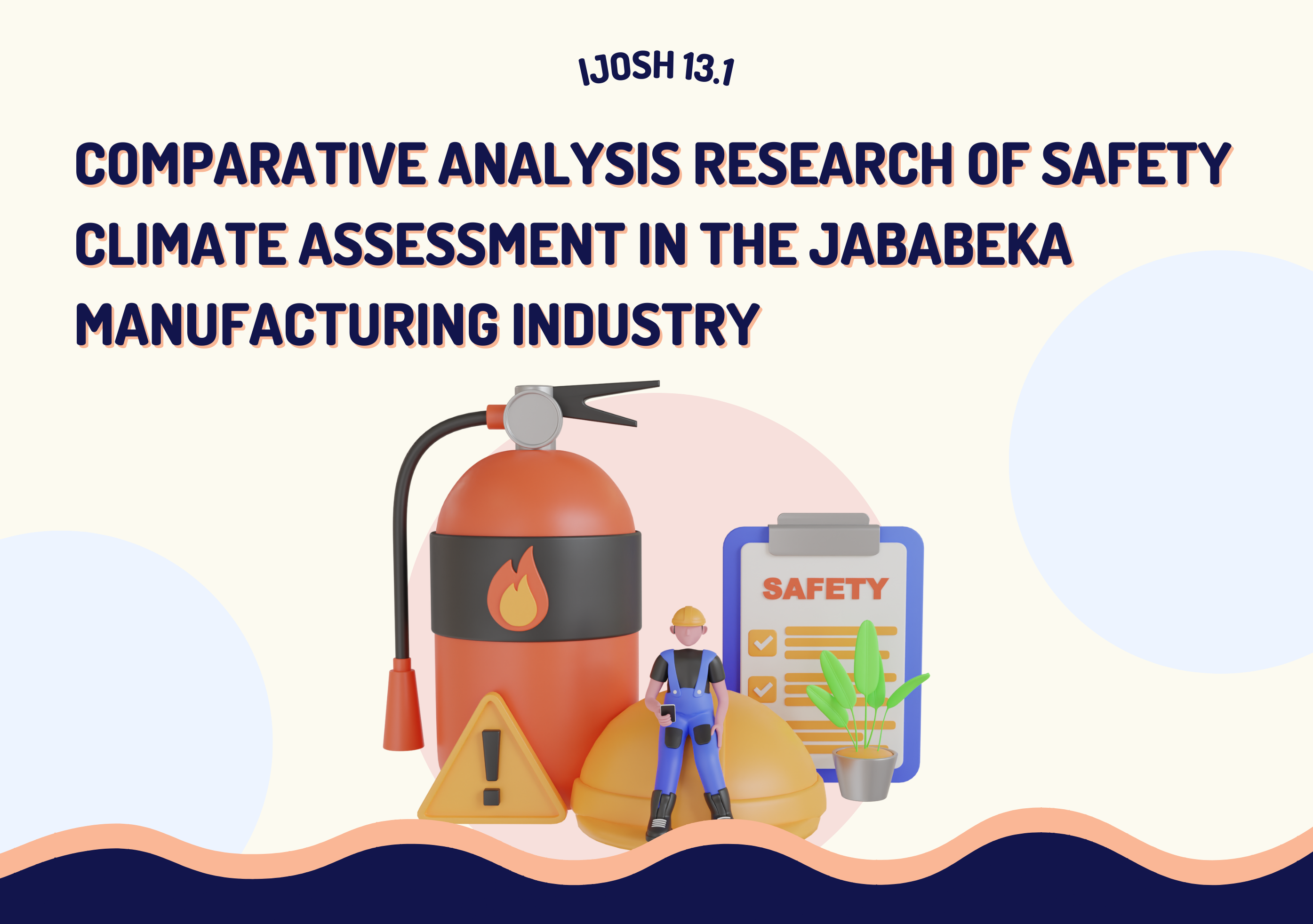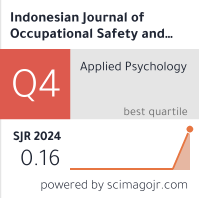Comparative Analysis Research of Safety Climate Assessment in the Jababeka Manufacturing Industry

Downloads
Introduction: The manufacturing industry transforms various materials, substances, or components into new products using mechanical, physical, or chemical forces. Safety climate refers to the perception of workers of prioritizing safety over organizational goals in the workplace. PT A, B, and C are manufacturing companies located in the Jababeka area. This study aims to identify the main factors that influence the perception of workers of safety climate in PT A, B, and C. Methods: A quantitative study with a cross-sectional design was conducted in August 2021 to analyze the safety climate of three companies. This study focused on various factors, such as leadership, risk management, implementation of occupational health and safety management system (OHSMS), regulation, management commitment, worker engagement, and worker competence. The sample size consisted of 330 workers selected from the three companies using the Lemeshow formula from a total of 1500 workers using the cluster sampling technique with the analysis of variance (ANOVA) test. Results: The results showed that risk management had the lowest score among the safety climate sub-variable for the three companies. Conclusion: The ANOVA test revealed a significant relationship among the safety climate variables. Furthermore, it is necessary to prioritize management in terms of policy and administration by involving all departments.
Abidin, A. et al. (2021) ‘Prevalence of Occupational Injury and Determination of Safety Climate in Small Scale Manufacturing Industry: A Cross-Sectional Study', Annals of Medicine and Surgery, 69(June), p. 102699.
Albert, A. et al. (2017) ‘Empirical Measurement and Improvement of hHazard Recognition Skill', Safety Science, 93, pp. 1–8.
Arefin, M. S. et al. (2022) ‘Employer Safety Obligations, Safety Climate, and Safety Behaviors in the Ready-made Garment Context in Bangladesh', Journal of Safety Research, 83, pp. 238–247.
Bhandari, S. et al. (2021) ‘Modeling the Relationship between Personal Risk Tolerance, Work-Related Risk Tolerance, and Risk-Taking Behavior of Construction Workers', Journal of Construction Engineering and Management, 147(4), pp. 1–10.
Bhandari, S. and Hallowell, M. R. (2022) ‘Influence of Safety Climate on Risk Tolerance and Risk-taking Behavior: A Cross-cultural Examination', Safety Science, 146(October 2021), p. 105559.
Comberti, L. and Demichela, M. (2022) ‘Customised Risk Assessment in Manufacturing: A Step towards the Future of Occupational Safety Management', Safety Science, 154(May), p. 105809.
Draghici, A. et al. (2022) ‘The Mediating Role of Safety Climate in the Relationship between Transformational Safety Leadership and Safe Behavior”The Case of Two Companies in Turkey and Romania', Sustainability (Switzerland), 14(14).
Ghasemi, F. et al. (2018) ‘A Path Analysis Model for Explaining Unsafe Behavior in Workplaces: the Effect of Perceived Work Pressure', International Journal of Occupational Safety and Ergonomics, 24(2), pp. 303–310.
Ghasemi, F. et al. (2020) ‘Analysis of Occupational Accidents among Nurses Working in Hospitals based on Safety Climate and Safety Performance: a Bayesian Network Analysis', International Journal of Occupational Safety and Ergonomics, 28(1), pp. 440-446.
Hon, C. et al. (2023) ‘Comparison of Management and Workers' Perception, Attitudes and Beliefs toward Health and Safety in the Ontario Manufacturing Sector', Journal of Safety Research, 84, pp. 364–370.
Memarbashi, E. et al. (2021) ‘The Relationship between Nurses' Safety Climate in the Operating Room and Occupational Injuries: A Predictive Correlational Study', Perioperative Care and Operating Room Management, 24(August), p. 100206.
Mes, G., Peker, M. and Do, O. C. (2022) ‘Role of Supervisor Behavioral Integrity for Safety in the Relationship Between Top-Management Safety Climate, Safety Motivation, and Safety Performance', 13, pp. 192–200.
Mofidi Naeini, A. and Nadeau, S. (2022) ‘STPA Systemic Approach for OHS and Operational Risk Analysis of Data Glove use in 4.0 Assembly', CIRP Journal of Manufacturing Science and Technology, 39, pp. 317–331.
Oah, S., Na, R. and Moon, K. (2018) ‘The Influence of Safety Climate, Safety Leadership, Workload, and Accident Experiences on Risk Perception: A Study of Korean Manufacturing Workers', Safety and Health at Work, 9(4), pp. 427–433.
Rahlin, N. A. et al. (2022) ‘A Review on the Importance of Safety Leadership Role on Safety Climate and Safety Performance in High Risk Industry', Lecture Notes in Networks and Systems, 486(September), pp. 159–171.
Singh, C., Singh, D. and Khamba, J. S. (2021) ‘Exploring an Alignment of Lean Practices on the hHealth and Safety of Workers in Manufacturing Industries', Materials Today: Proceedings, 47, pp. 6696–6700.
Summers, D. et al. (2022) ‘The Development of a Brief and Practical Work Safety Climate Measure', International Journal of Industrial Ergonomics, 87(June 2021), p. 103255.
Syed-Yahya, S. N. N., Idris, M. A. and Noblet, A. J. (2022) ‘The Relationship between Safety Climate and Safety Performance: A Review', Journal of Safety Research, 83, pp. 105–118.
Todaro, N. M. et al. (2023) ‘Safety Climate in High Safety Maturity Organisations: Development of a Multidimensional and Multilevel Safety Climate Questionnaire', Safety Science, 166(June).
U.S Bureau of Labor Statistic (2022) Manufacturing: NAICS 31-33. United State.
Wang, C. M. et al. (2016) ‘Influence of Personality and Risk Propensity on Risk Perception of Chinese Construction Project Managers', International Journal of Project Management, 34(7), pp. 1294–1304.
Wu, Z. et al. (2021) ‘Manufacturing Process Similarity Measurement Model and Application based on Process Constituent Elements', International Journal of Production Research, 59(14), pp. 4205–4227.
Yang, F. et al. (2023) ‘Visualized analysis of safety climate research: A bibliometric data mining approach', Safety Science, 158(2), p. 105973.
Yang, T. et al. (2021) ‘Intelligent Manufacturing for the Process Industry Driven by Industrial Artificial Intelligence', Engineering, 7(9), pp. 1224–1230.

This work is licensed under a Creative Commons Attribution-NonCommercial-ShareAlike 4.0 International License.

In order to be accepted and published by The Indonesian Journal of Occupational Safety and Health, Author(s) who submit an article should complete all the review process. The copyright of received articles assigned to the The Indonesian Journal of Occupational Safety and Health and Department of Safety and Health, Universitas Airlangga as publishers of the journal. The intended copyright includes the rights to publish articles in various forms (including reprints).
The Editorial Team of The Indonesian Journal Of Occupational Safety and Health and Department of Safety and Health strive to ensure that no errors occur in the articles that have been published, both data errors and statements in the article.
Users of this website will be licensed to use materials from this website following the Creative Commons Attribution-NonCommercial-ShareAlike 4.0 International License. No fees charged. Please use the materials accordingly.
------------------------------------------------------------------------------------------------------------------------------------------------------------------------------------------
Attribution ” You must give appropriate credit, provide a link to the license, and indicate if changes were made. You may do so in any reasonable manner, but not in any way that suggests the licensor endorses you or your use.
NonCommercial ” You may not use the material for commercial purposes.
ShareAlike ” If you remix, transform, or build upon the material, you must distribute your contributions under the same license as the original.







 How to Submit Articles in OJS
How to Submit Articles in OJS

























